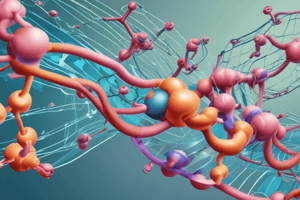Podcast
Questions and Answers
Explain the four levels of protein structure.
Explain the four levels of protein structure.
The shape of a protein can be described by four levels of structure: primary, secondary, tertiary, and quaternary.
What is primary structure?
What is primary structure?
Primary structure is the unique and linear sequence of amino acids in a protein.
What defines secondary structure in proteins?
What defines secondary structure in proteins?
Secondary structure describes regions where the polypeptide is folded into localized shapes, including alpha helix and beta pleated sheet.
What is tertiary structure?
What is tertiary structure?
What is quaternary structure?
What is quaternary structure?
What is the difference between fibrous and globular proteins?
What is the difference between fibrous and globular proteins?
Explain the significance of polar and non-polar amino acids.
Explain the significance of polar and non-polar amino acids.
Study Notes
Levels of Protein Structure
- Proteins are structured in four levels: primary, secondary, tertiary, and quaternary.
Primary Structure
- Unique linear sequence of amino acids in a protein, determining its folding and shape.
- The sequence is determined during translation with 20 different amino acids resulting in nearly infinite combinations.
- Small alterations in primary structure can significantly impact protein function.
Secondary Structure
- Involves localized folding patterns within the polypeptide chain.
- Two main types: alpha helix and beta pleated sheet.
- Alpha helix forms via hydrogen bonding within the same chain, while beta sheets arise from hydrogen bonds between different chains or sections.
Tertiary Structure
- Represents the overall three-dimensional shape of the protein, affecting functionality.
- Most proteins (e.g., lysozyme, hemoglobin) have a compact globular shape; fibrous proteins (e.g., collagen, keratin) retain extended structures.
- Influenced by various interactions: ionic bonds between charged R-groups, hydrogen bonds, and hydrophobic interactions.
- Disulfide bridges, formed by cysteine residues, are critical for stabilizing tertiary structure.
Quaternary Structure
- Occurs in proteins composed of multiple polypeptide chains.
- Enhances biological diversity and activity; for example, collagen consists of three intertwined subunits, while hemoglobin has four distinct polypeptides.
- Prosthetic groups, non-peptide molecules bound to proteins, are vital for functions like oxygen transport in hemoglobin.
Fibrous vs. Globular Proteins
- Globular proteins (e.g., enzymes like lysozyme) exhibit compact structures, enhancing functionality.
- Fibrous proteins (e.g., collagen and keratin) have extensive formations, providing structural support.
Significance of Polar and Non-Polar Amino Acids
- Amino acids differ based on R groups; some are polar (charged), while others are non-polar (hydrophobic).
- Polar amino acids are hydrophilic, promoting water solubility, while non-polar amino acids favor aggregation in aqueous environments.
- The hydrophilic/hydrophobic nature influences protein folding and cellular membrane interactions.
- Membrane proteins are dual-faced, engaging with both extracellular fluid and cytoplasm, with a hydrophobic core that anchors them within lipid bilayers.
- Polar-lined protein channels facilitate the transport of polar molecules across membranes, highlighting the functional importance of amino acid polarity.
Studying That Suits You
Use AI to generate personalized quizzes and flashcards to suit your learning preferences.
Description
Test your knowledge of protein structure with this set of flashcards focused on chapter C.1. Explore the four levels of protein structure: primary, secondary, tertiary, and quaternary, and understand their significance in biology.



